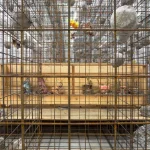Originally published in the December 2021 ‘Power 100’ issue of ArtReview
This was the year that the art object was finally dematerialised. It’s not that eye-melting amounts weren’t still being paid for physical things, of course. After COVID-19 and lockdowns, the art auction market has come roaring back; at the Sotheby’s sale of the collection of Harry and Linda Macklowe in November, a painting by Mark Rothko went for $82.5m, a sculpture by Alberto Giacometti for $68m. Physical artworks continue to attract financial value to them, in which money is captured and congealed, in vast amounts.
But with the incursion of nonfungible tokens – NFTs – into the art market over the last year, the link between physical thing and market price seems to have finally unravelled. A common refrain in the often-bewildered response to the millions paid in cryptocurrency in the much-hyped sales of NFTs over the last months is, ‘But what are you actually buying?’ Images and video animations that, by default, can be viewed on any screen, anywhere, should be endlessly reproducible and impossible to commodify. Yet with the development of the NFT protocol, based on the Ethereum blockchain, an apparently hard and verifiable guarantee of uniqueness (or limited edition) can now be tied to these ‘digital goods’. Virtual objects, generated by code, can now be as rare as a handmade art object.
The headline-grabbing sales of Mike Winkelmann/Beeple’s 2020 Collection last December, then topped by the $69m paid for his Everydays: The First 5,000 Days at Christie’s in March, jolted the art market into realising that digital culture could finally be aligned with its own commercial paradigm of rarity and exclusivity. Suddenly, all the physical paraphernalia of art galleries, museums and objects to go in them have become, if not exactly redundant, then not wholly necessary for the economy of collecting to thrive. With the apparent guarantee of title of ownership that NFTs promise, data becomes ownable, and the physical aspect of rarity becomes secondary, since so much of the market value of contemporary art lies not in the object, but the circulation of its image through digital culture.
The significance of this can’t be underestimated, partly because one of the consequences of making rare objects virtual and available on a common standard of exchange is that the culture of collecting becomes universalised – putting the superrich collector and the little guy, elite culture and mass culture, side by side on the same platform. The collector market for artworks is only one market for collectibles, but traditionally the art market has been aligned with the other luxury-object tastes of the 1 percent, in particular design objects and high fashion, so that the artworld has tended to exist in distinction to mass culture.
Yet pop culture is full of its own collectors. Even though pop culture is, on the surface, about mass-reproduced goods, its audience also covets rarity. The merchandise of fandom – limited-edition models and figurines, trading cards, the memorabilia of film and TV, music on vinyl – are artefacts that, although tied to the images and sentiments of pop culture, are still made rare and desirable, and can be owned. In October a pair of Michael Jordan’s red and white Nike Air Ships, worn during his first season with the Chicago Bulls, in 1984, sold for $1.47m.
But, as mass culture has known for some time now, collecting is becoming virtual. In the world of online gaming, for example, virtual objects command a market, in the form of ‘in-game virtual goods’. According to one estimate, the global online microtransaction market was worth $33bn in 2020. Millions of people will buy objects that persist within the space of a particular game.
It was only a matter of time before this commodification of digital content would appear in millennial visual culture, and the NFT explosion begins to make sense if one considers that digital-native artists are the generation keen to find ways to monetise their creativity, at a moment when their economic prospects seem more precarious than ever. It’s a reasonable aspiration to make a living from your own creative work. But the response to the COVID-19 pandemic shut down much physical culture, at a time when online culture was already being monopolised by the big platforms. Performing musicians, for example, were badly hit by the closure of live music and were quick to see the possibility of an alternative to miserly streaming royalties – a week before Winkelmann’s Christie’s sale in March, the band Kings of Leon issued their new album (albeit still with a physical version available) to be bought via an NFT, racking up $2m in sales. In November legendary producer Timbaland released elements of his forthcoming EP as NFTs. With musicians increasingly at odds with streamers over revenues, alternative platforms for monetising your fanbase will continue to be attractive.
Similarly, for a generation of commercial visual artists, trained in graphic design, illustration, CGI and video, NFT offers the promise of a vehicle by which the price of one’s creative work can be controlled and traded, at a time when the economy of digital culture has tended to strip creatives of ownership and control. Winkelmann, remember, once earned a living making visuals for events, making his Everydays images for years before he had even heard of NFTs, steadily building his fanbase on Instagram.
None of this can be separated from the hype around cryptocurrency, of course. The NFT explosion makes sense as the merging of cryptocurrency with the fan culture of digital goods, led by often-underpaid digital ‘creatives’. The marketplace for images of bored apes, or cryptopunks, or any of Winkelmann’s fevered, derivative imaginings, is one founded on the torrent of exchanged value flowing through the Ether (Ethereum’s cryptocurrency). That this kind of visual art has become a form of bragging rights for crypto millionaires is because there are now such people as crypto millionaires. But as the value of cryptocurrencies like Ether and Bitcoin continues to rise, the incentive to market your creative work in this particular form becomes vividly attractive. Distinguishing the artist’s desire for control over their creative work and the speculative mania driving cryptocurrency is pointless, since there’s money to be made on both counts.
This doesn’t necessarily mean any of this will be more equitable for artists, of course. The big NFT trading platforms, such as Nifty Gateway and OpenSea, are in the business of making money from artists too. But the lure for all involved is hard to resist. For a culture increasingly conducted online, and with virtual reality and augmented reality being touted by big tech as the next big thing, the pressure to turn data into objects that can be traded in virtual currency by net-natives who are as much online as ‘AFK’ is building. Mark Zuckerberg’s hour-long October ‘keynote’ video, heralding Facebook’s conversion to the ‘Metaverse’, has a fleeting glimpse of the new art object – as Zuck’s hipster friend dials in to tell him about the “AR street art” she’s finding “all over SoHo” the swirling virtual artwork starts to fade. “Hold on,” she says, “I’ll tip the artist, and they’ll extend it.” In the future, artists will all be tipped by tech billionaires.
But the dematerialisation of rarity was always going to happen. For years, video and digital artists, their gallerists and lawyers, have concocted contracts to limit the supply of artworks that are inherently reproducible. Art stars have discovered the vast sums that can be made from editioning works, and that the certificate of authenticity is the only document that really counts, without which a work becomes worthless. We may like to think that the NFT explosion is driven by speculative delusion. That may turn out to be true. But in principle it resolves the problem of rarity for the age of digital content, adding the strange allure of ownership (and of course speculation) to the intangible culture of images in which we increasingly live.



